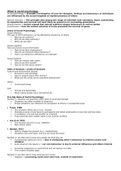Class notes
A-level/University Comprehensive overview of social psychology
- Course
- Institution
- Book
A comprehensive summary of social psychology lecture notes including social influence, aggression, stereotypes etc Suitable for 1st- year university and A-level students
[Show more]



